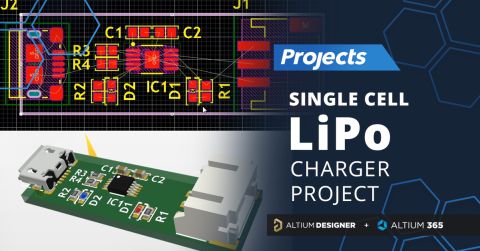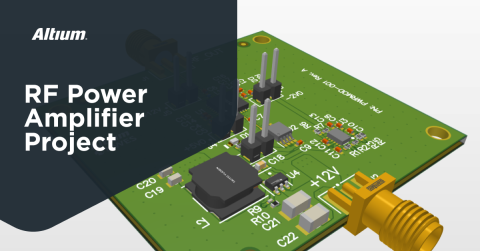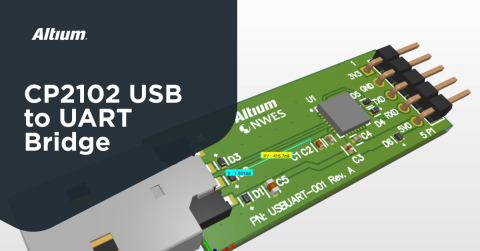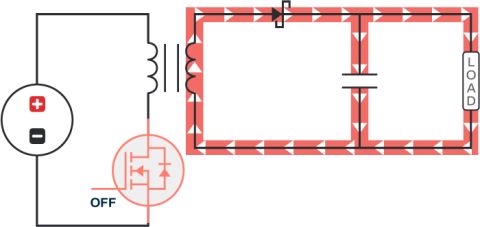45V-5A Adjustable Half-Bridge DC to DC Converter

Introduction
DC-to-DC buck converters are widely used in electronic devices. Three main types of non-isolated DC-to-DC converters are Buck, Boost, and Buck-Boost. The most commonly used type is the Buck converter. Today, I will introduce you to an adjustable half-bridge buck converter that can handle input voltages ranging from 6V to 45V and deliver a continuous output of up to 5A. You can also adjust the output voltage, so if current adjustment isn't necessary, this circuit can serve as a power supply.
The design employs a separate PWM controller and Half-Bridge driver chip, which allows you to adapt it for higher voltages and currents with minimal modifications. The switching frequency is set at around 65KHz, but you can get to a higher switching frequency by using a different part number for the Half-Bridge driver chip and recalculating the switching inductor.
Using Altium Designer 23 to create the schematic and PCB, I gathered the necessary component information and quickly generated the Bill of Materials (BOM) via the Octopart website. Using an oscilloscope, DC load, and a benchtop multimeter, I tested the circuit for voltage stability, output noise, and load step response. It's a nice piece of hardware, so let's get started!
Specifications
-
Input Voltage: 6-45V DC
-
Output Voltage: 3V to Vin-3
-
Output Current: 5A - Continuous (up to 6 - 7A short run)
-
Output Noise (20MHz BWL): 5mVp-p (no load), 30mVp-p (5A)
-
Input Power: 12V - Regulated
-
Switching Frequency: 65KHz
Circuit Analysis
Below you will see a schematic diagram of the circuit. You might notice the two main components of the circuit are the UC3843 [1] PWM controller chip and IR2104 [2] half-bridge MOSFET driver.
IC1 is the famous UC3843 PWM controller, generating 65KHz square pulses for the half-bridge driver chip, IC2. The switching frequency of IC1 is determined by R1 and C5. The chip supply rail passes through an RC filter that is created using R2, C3, and C4 to minimize the noise. The chip requires a 12V supply, which should be externally provided for the circuit to cover output voltages below 12V as well.
P1 is a 2.5mm XH connector that delivers a regulated 12V supply to the board. C1 and C3 are used to reduce noise, and D1 indicates a correct supply connection. This supply rail also powers the IC2 chip.
IC2 is a well-known half-bridge driver that internally manages ON/OFF and dead-time functions. However, the realistic input switching frequency is not high enough for some SMPS applications in general. In practice, I haven’t seen issues in power delivery for frequencies up to 65KHz by using this driver chip and MOSFETs. For higher switching frequencies, a faster half-bridge driver is mandatory.
R7 functions as a pull-up resistor to keep IC2 ON. C10 and C11 serve as decoupling capacitors for the supply rail, while C9 acts as a bootstrap capacitor.
Q1 and Q2 are IRFR3710Z D-PACK SMD MOSFETs [3] with the 18-milliOhm RDS(on) rating at 25°C. This allows us to utilize these MOSFETs for currents up to 5A without the need for external heatsinks. R5 and R8 are used to limit the current to the MOSFET Gates.
C7 and C8 rated at 1000uF-50V [4], serve as input decoupling capacitors, reducing noise and stabilizing the buck converter. C12 through C15 are output capacitors, placed in parallel to minimize Equivalent Series Resistance (ESR) and reduce noise further. R9 and R10 (10K 2512 SMD resistors [5]) provide an initial load and stabilize the output. R6 is a multi-turn 10K potentiometer used for adjusting the output voltage, where C8 stabilizes the feedback network. L1 is wound on a yellow-white toroidal iron powder core, which will be discussed in the next step.
Inductor
The inductor core is a yellow-white (-26 material) toroidal iron powder core (Figure 2). Dimensions of the core are as follows:
-
Outer Diameter: 33mm
-
Inner Diameter: 19.5mm
-
Ring Height: 11.2mm
The closest part number for this core is T130-26 from Micrometals [6]. To wind the inductor, you need to prepare four 0.50mm copper wires (4 wires in parallel), with an identical length of 2.2M for each. The total inductance should not be below 220uH, so you need an LCR meter to measure the inductance.

Figure 1: T130-26 material yellow-white toroidal iron-powder core
PCB Layout
You will find the PCB layout of the circuit above. It’s a two-layer PCB board that contains a mixture of SMD and through-hole components. As you will see, a few PCB power planes might carry high voltages, which is why they have a higher-than-normal clearance than other NETs. Please watch the video for more information regarding the PCB.
Assembly and Test
Figure 2 shows a fully assembled PCB board. The smallest package size is 0805, so you shouldn’t have any problem soldering the components by hand.

Figure 2: Assembled PCB board of the Half-Bridge adjustable DC to DC converter
I performed several tests using the Siglent SDS2102X Plus oscilloscope, SDM3045X multimeter, and SDL1020X-E DC load. The circuit demonstrated acceptable results for stability, voltage drop, output noise, and load step response. Please see the video for more information regarding testing. Figure 3 shows the output noise of the circuit under no load.

Figure 3: Output noise of the buck converter (no load)
Figure 4 shows the output noise under the maximum 5A load.

Figure 4: Output noise of the buck converter (maximum 5A load)
Figure 5 shows the step response test results, for the rising edge of a 0.5A to 5A current pulse.

Figure 5: Load step response test (rising edge trigger of the 0.5A to 5A current pulse)
Figure 6 shows the step response test results, for the falling edge of a 5A to 0.5A current pulse.

Figure 6: Load step response test (falling edge trigger of the 5A to 0.5A current pulse)
And here you have a full video about this project:
You can download the project files from Altium-365 cloud space here: Altium Community Projects Workspace
References
[1]: UC3843: https://octopart.com/uc3843bd1013tr-stmicroelectronics-496384?r=sp
[2]: IR2104: https://octopart.com/ir2104spbf-infineon-65872813?r=sp
[3]: IRFR3710Z: https://octopart.com/irfr3710ztrpbf-infineon-65874131?r=sp
[4]: 1000uF-50V: https://octopart.com/eeufr1h102-panasonic-13148191?r=sp
[5]: 10K-2512: https://octopart.com/crgcq2512j10k-te+connectivity-91018617?r=sp
[6]: T130-26: https://octopart.com/t130-26-micrometals-34992736?r=sp












